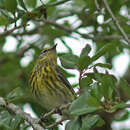en
names in breadcrumbs


A medium-sized (5 inches) wood warbler, the male Cape May Warbler is most easily identified by its streaked olive back, streaked yellow breast and flanks, and yellow face with prominent rusty cheek patches. Female Cape May Warblers are similar to males, but are duller and lack rusty patches on the face. The male is relatively unmistakable in good light, but the female may be confused with other female wood warblers with streaked flanks, such as the female Blackburnian Warbler (Setophaga fusca). The Cape May Warbler primarily breeds in south-central Canada. Smaller numbers breed south of the U.S. border in the upper Midwest and northern New England. The Cape May Warbler winters from the Florida Keys and the Bahamas south to southern Mexico and Central America. Cape May Warblers breed in northern evergreen forests, particularly in areas where spruce and fir trees occur. In winter, this species may be found in a number of shrubby habitat types, including mangroves and forest edges. Cape May Warblers mainly eat small invertebrates, including insects and spiders, although this species may eat fruits or berries in winter. In appropriate habitat, Cape May Warblers may be observed foraging for food located on leaves, needles, and branches in the forest canopy. Birdwatchers may also listen for this species’ song, a high-pitched “seet” note repeated several times in quick succession. Cape May Warblers are primarily active during the day.
The Cape May warbler (Setophaga tigrina) is a species of New World warbler. It breeds in northern North America. Its breeding range spans all but the westernmost parts of southern Canada, the Great Lakes region, and New England. It is migratory, wintering in the West Indies. This species is a very rare vagrant to western Europe, with two records in Britain as of October 2013. The English name refers to Cape May, New Jersey, where George Ord collected the specimen later described by Alexander Wilson. This species was not recorded again in Cape May for another 100 years, although it is now known as an uncommon migrant there.[2]
The genus name Setophaga is from Ancient Greek ses, "moth," and phagos, "eating", and the specific tigrina is Latin for "tiger-striped" from tigris, "tiger".[3]
This bird is a small passerine and is a mid-sized New World warbler. Length can vary from 12–14 cm (4.7–5.5 in), wingspan is 19–22 cm (7.5–8.7 in), and body mass can range from 9–17.3 g (0.32–0.61 oz).[2][4][5] Among standard measurements, the wing chord is 6.1–7.3 cm (2.4–2.9 in), the tail is 4.3–5 cm (1.7–2.0 in), the bill is 0.9–1.2 cm (0.35–0.47 in) and the tarsus is 1.7–1.9 cm (0.67–0.75 in).[6] The adult male Cape May warbler has a brown back, yellowish rump and dark brown crown. The underparts are yellow streaked with black, giving rise to the bird's scientific name. The throat and nape are bright yellow and the face has a striking chestnut patch framed in yellow with a black eyestripe.[7] There is a narrow white wing bar.
Plumages of the female and immature male resemble washed-out versions of the adult male, lacking the strong head pattern. The yellowish rump, and at least indications of the white wing bar, are always present.
This species is insectivorous and lays larger clutches in years when spruce budworm is abundant. It picks insects from the tips of conifer branches or flies out to catch insects. The Cape May warbler also feeds on berry juice and nectar in winter, and has, uniquely for a warbler, a tubular tongue to facilitate this behavior.[2]
The breeding habitat of this bird is the edges of coniferous woodland. Cape May warblers nest in dense foliage near the trunk of the tree, commonly the black spruce, and lay 4–9 eggs in a cup nest. This species can lay the largest clutch of any New World warbler, probably in response to increases in the numbers of spruce budworm during outbreaks.[2]
The song of the Cape May warbler is a simple repetition of high tsi notes. The call is a thin sip. This bird usually sings from high perches.[2]
The Cape May warbler (Setophaga tigrina) is a species of New World warbler. It breeds in northern North America. Its breeding range spans all but the westernmost parts of southern Canada, the Great Lakes region, and New England. It is migratory, wintering in the West Indies. This species is a very rare vagrant to western Europe, with two records in Britain as of October 2013. The English name refers to Cape May, New Jersey, where George Ord collected the specimen later described by Alexander Wilson. This species was not recorded again in Cape May for another 100 years, although it is now known as an uncommon migrant there.